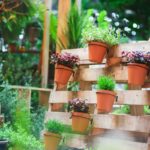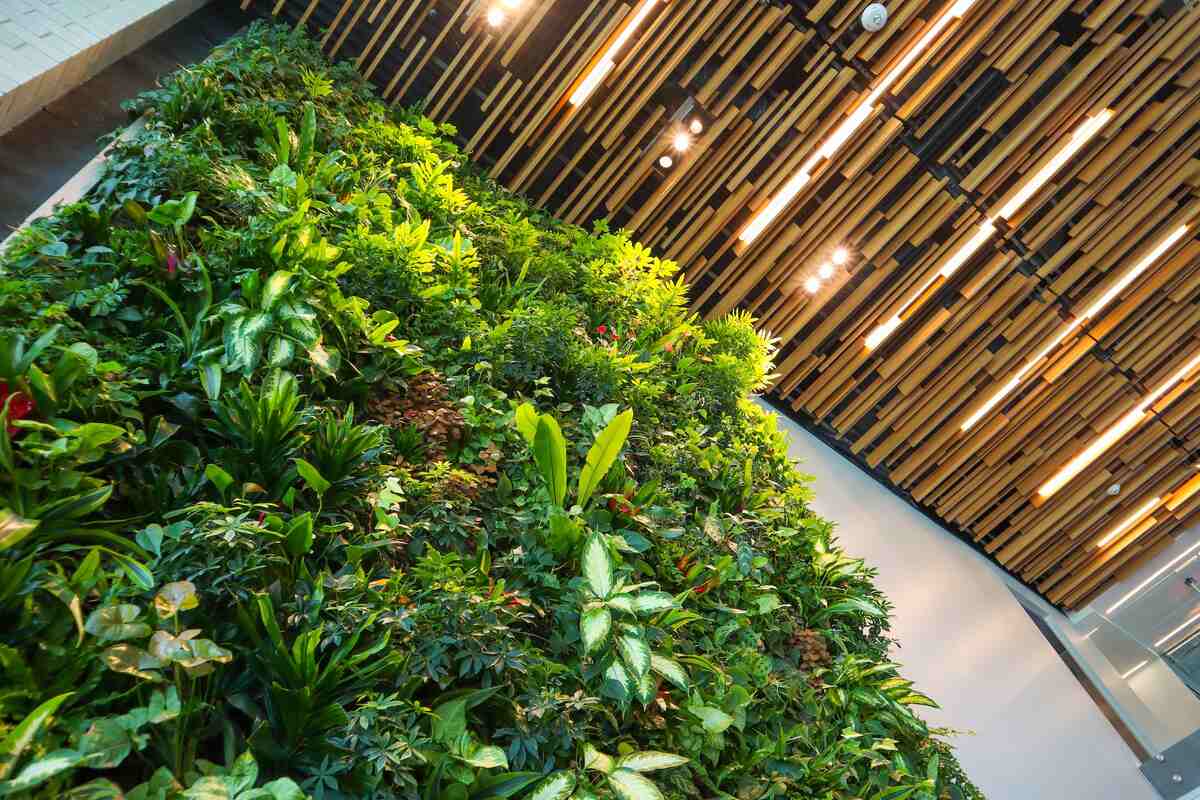
Whether you’re a luxury Chicago condo owner or a studio apartment dweller, these 20 vertical gardening ideas will exercise your green thumbs without hogging valuable space (and you don’t need a big courtyard for these ideas either).
A greater sense of well-being, no digging in the hot sun, and gardening on walls – vertical gardening is perfect for people living in high-rises or tight quarters. Instead of cluttering your tables with potted plants or watching the cucumber vines take over the vegetable patch, design a vertical garden that grows up, up, and up.
We’ve gathered 20 vertical gardening ideas to inspire your creativity and bring your city-living gardening dreams to life. Advantages, best plants to grow, maintenance tips, and costs – we’ll cover the deets on each idea.
- 1. Look to the Ceiling
- 2. Accessorize a Tiered Ladder
- 3. Spruce Up the Bookshelves
- 4. Install Floating Wall Shelves
- 5. Mount or Clip a Wall Garden
- 6. Show Off a Window Box
- 7. Design a Pallet Planter
- 8. Repurpose Your Shoe Organizer
- 9. Build a DIY Succulent Wreath
- 10. Rely on a Smart Garden
- 11. Build or Buy a Hydroponic System
- 12. Reuse old water bottles
- 13. Grow an Aeroponics Garden
- 14. Watch Climbers Grow up a Trellis
- 15. Upcycle Your Gutters
- 16. Stack Your Garden Beds
- 17. Dress Up Your Drawers
- 18. Use an A-Frame
- 19. Get Crafty with Crates
- 20. Build a Living Wall
- Advantages of Vertical Gardening
- When to Call a Gardening Pro
1. Look to the Ceiling
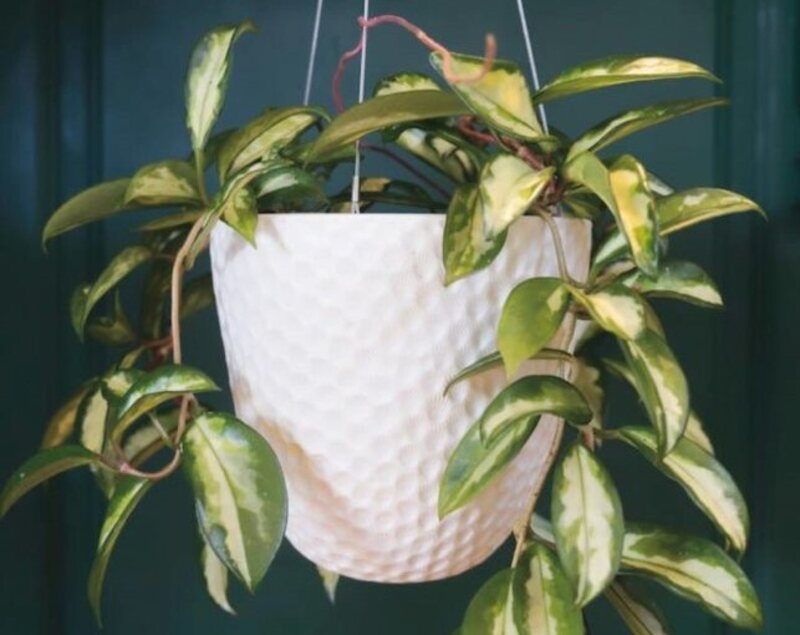
Your ceiling is a great asset when it comes to vertical gardening. If your horizontal surfaces – like tables or shelves – are overcrowded, and pictures and paintings pack your walls, then hanging your plants from the ceiling is the way to go.
Need some ideas? Hang a vertical herb garden in your kitchen, or hang a few of your favorite trailing plants in the bathroom (it will make your self-care days extra relaxing).
Advantages:
- Hanging your plants helps keep them away from curious children or rambunctious pets.
- Saves limited space on your horizontal surfaces
- Easy to vary the hanging heights. You can hang all your plants at a uniform height or experiment with different levels.
- Allows you to grow those long, trailing plants you’ve always wanted to grow.
Best plants:
- String of pearls
- Burro’s tail
- Golden pothos
- Boston fern
- English iIvy
- Ripple peperomia
- Spider plant
Maintenance tips:
- Planter pots can get heavy after adding potting soil and water. Before hanging your pots, make sure to purchase durable hooks and hanging baskets that can hold the weight.
- Leave plenty of space between the wall and your plant. A pot hanging too close to the wall could scrape the paint or prevent the plant from growing.
- Keep your plants healthy with good drainage (and your white furniture undamaged). Either keep the plant in two pots – one with drainage holes and the other without – or make sure the hanging pot has an attached saucer to collect the drainage.
Cost: Ceiling hooks typically cost between $2 and $15, depending on durability and style. A hanging planter costs around $15.
2. Accessorize a Tiered Ladder
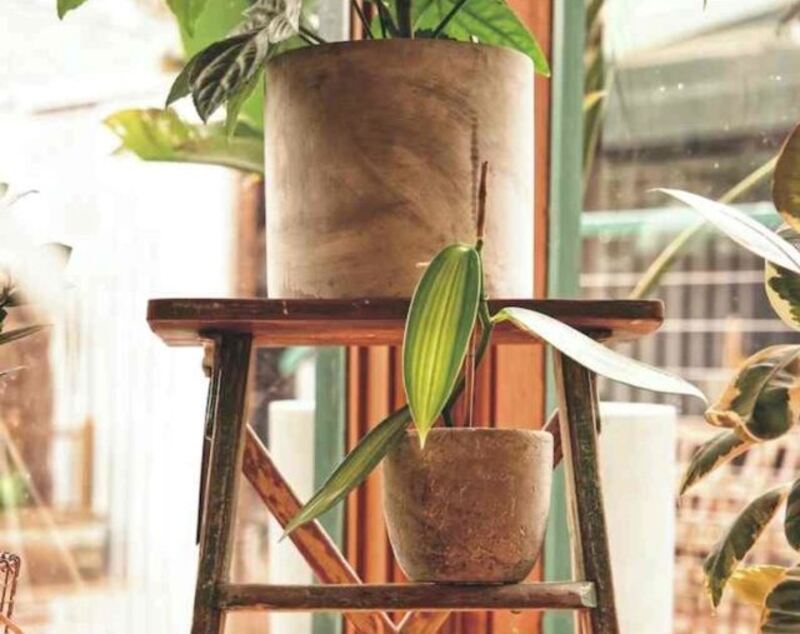
If you’re buying a ladder to hang your ceiling plants or water the plants in hard-to-reach places, consider turning the ladder into a vertical garden when it’s not in use. A tiered ladder can make an excellent vertical surface for your potted friends, and it will fit nicely with Boho or shabby chic home decor.
Unlike the hooks in your ceiling garden, this vertical garden idea is not permanent. A ladder garden allows for easy rearrangement of plants, and you can reutilize the ladder at any time.
Advantages:
- Two-in-one: A useful ladder and a beautiful display
- A ladder can also act as a trellis for flowering vines.
Best plants:
We recommend pretty flowers that will turn the vertical garden into a focal point, but herbs work just as well for this ladder idea. You’ll want to stick with plants that grow well in containers.
- Geranium
- Orchid
- Succulents
- African violets
- Peace lily
Maintenance tip: Fungus gnats love your moist potted plants. If your vertical garden is being devoured by fungus gnats, there are plenty of remedies to get rid of these pests. Let the soil completely dry out before the next watering or apply neem oil to keep these unwanted visitors under control.
Cost: A wooden tiered ladder typically costs between $50 and $150.
3. Spruce Up the Bookshelves
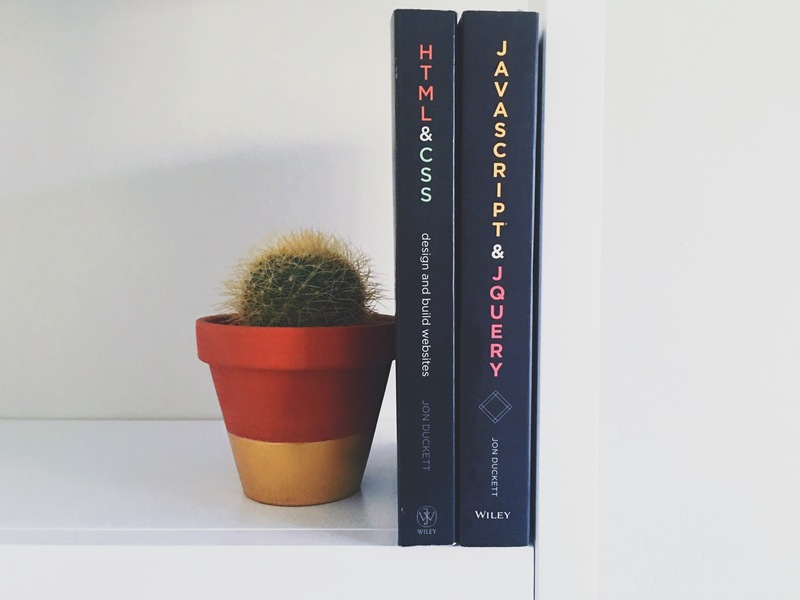
Your bookshelf tends to hold many of life’s answers. Does it hold the answers to your vertical garden?
Add some glam to your bookshelves with small potted plants (to act as bookends, of course), or adorn the top shelves with trailing plants.
Advantages:
- Allows you to grow your favorite trailing plants if hanging them from the ceiling is not possible.
- Easy rearrangements
- Easy to water
- An eye-catching plant can accentuate your favorite stack of books.
Best plants:
Want your bookshelves to attract the eye? Try growing trailing plants or textured plants.
- Succulents
- Devil’s ivy
- Spider plant
- Lipstick plant
- Inch plant
- Chain of hearts
Maintenance tip: Keep an eye on your trailing or climbing plants – these growers can get out of control if not kept in line. Remember to prune and trim these plants to ensure healthy and controlled growth.
Cost: Trailing plants usually cost between $10 and $20 each, though this can vary depending on the plant type.
4. Install Floating Wall Shelves
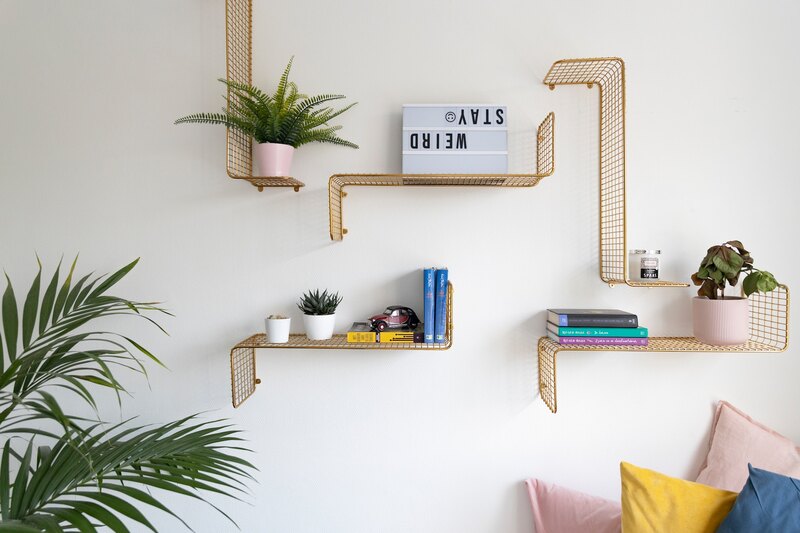
If your walls are bare and you need extra space for your herb garden or potted plants, installing floating shelves can be just the ticket. There are plenty of shelving sets to choose from with different designs, shapes, and colors. Decorate them with your favorite trinkets, pet rocks, and potted plants to create a charming wall garden.
Advantages:
- This vertical wall garden idea lets you choose the perfect spot where the plants will get the most sun.
- You get to decide the appropriate shelf heights – no bending over or ladders needed when watering or maintaining this vertical garden.
Best plants:
A potted herb garden in the kitchen would make all the difference to your cooking. These are among the best herbs for container gardening:
- Mint
- Basil
- Rosemary
- Sage
- Thyme
- Lemon balm
- Parsley
- Oregano
Maintenance tip: Pick your herbs often to encourage new growth. Start picking from the outermost leaves.
Some herbs start to lose their delicious flavor when flowers begin to form. Pinch off any flower buds to ensure the herbs retain their mouthwatering taste.
Cost: A packet of herbs typically costs between $1 and $2. Shelf sets range between $20 and $30 depending on the set’s size and design.
5. Mount or Clip a Wall Garden
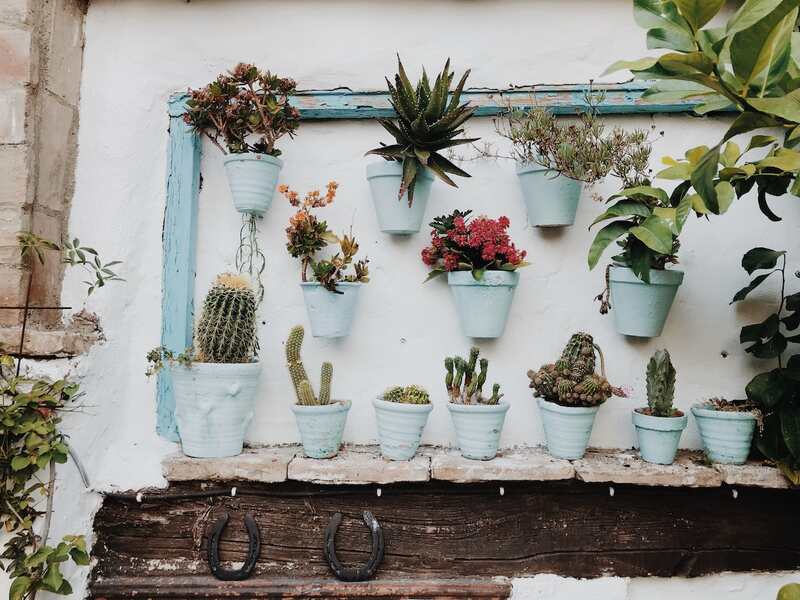
If your container garden is swallowing up your small front yard, or your potted flowers are taking over your workspace, turn to the walls for support. Using a clip hanger or flower pot wall mount, you can put your plants on instant display and finally reclaim your small space.
Advantages:
- Mounting your flower pots doesn’t require shelving or any other supportive surface. One clip hanger or wall mount is all you need to start this vertical garden idea.
- Choosing where to mount the pot allows you to take advantage of the sunny spots in your home.
- Hanging your plant on the wall will turn it into a fun art piece.
Best plants:
Terracotta pots are simple to hang because the clips and wall mounts can grasp at the pot’s rim with ease. Terracotta pots don’t retain moisture, so it’s wise to pick plants that don’t mind the dryness, such as succulents and cacti.
Maintenance tip: If you’re hanging your terracotta plants indoors, make sure the pots have a saucer attached to catch the drainage.
Cost: Clips usually cost about $1 each and are often sold in sets. Wall mounts average about $3. Terracotta pots may range between $1 and $10 or more, depending on the size.
6. Show Off a Window Box
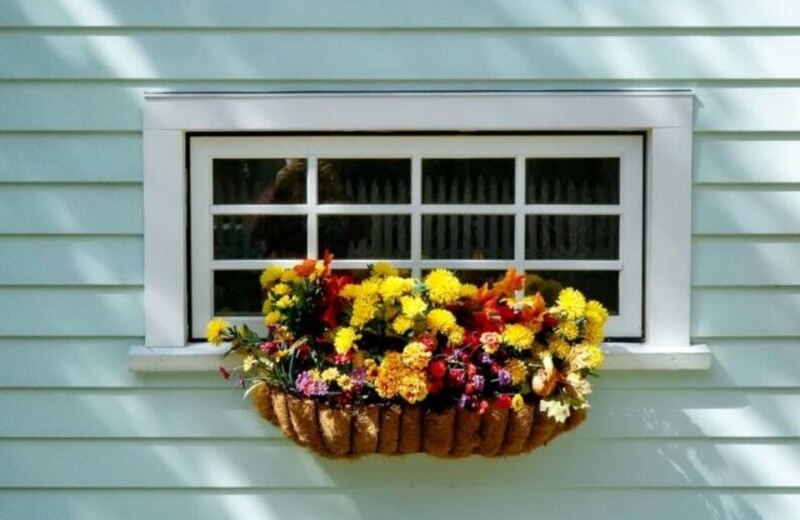
Your Chicago home will stand out from the rest with this vertical garden idea. Embellish your windows with floral window boxes. These containers can feature a wide variety of colors and textures and are a great way to make the neighbors’ jaws hit the floor.
If you have a window by your kitchen, why not turn your window box into a small herb garden? When you’re making your Chicago-style deep dish pizza, sprinkle on some fresh herbs straight from the window box. If your kitchen window has an adjustable screen or no screen at all, that will make picking herbs even easier.
Advantages:
- Limited weeds
- Offers a beautiful view from your window
- A window box can help cover up those unsightly scratches on your window frame.
- Adds a splash of color and texture to your Chicago home’s exterior
- Growing your plants by the window puts them at eye level, catching the eyes of passersby.
Best plants:
Your window box can show off various plants with different colors, textures, and growth patterns. Before filling your window box with plants, make sure each plant has the same sun requirements.
Window box plants that prefer sun:
- Marigold
- Dusty miller
- Rosemary
- Periwinkle
- Lavender
Window box plants that prefer shade:
- Parsley
- Snapdragon
- English daisy
- Pansies
- Johnny jump-ups
Climbing window box plants:
- Carolina jessamine
- Moon vine
- Honeysuckle
Trailing window box plants:
- English ivy
- Strawberries
- Alyssum
Maintenance tip: Make sure all your plants grow well together. Since they’ll all share the same container, you don’t want to combine plants that require different growing conditions. Stick with flowers that harmonize, and your maintenance routine will be easy to follow.
Cost: Window box prices will vary between $5 and $400 depending on its design and material.
7. Design a Pallet Planter
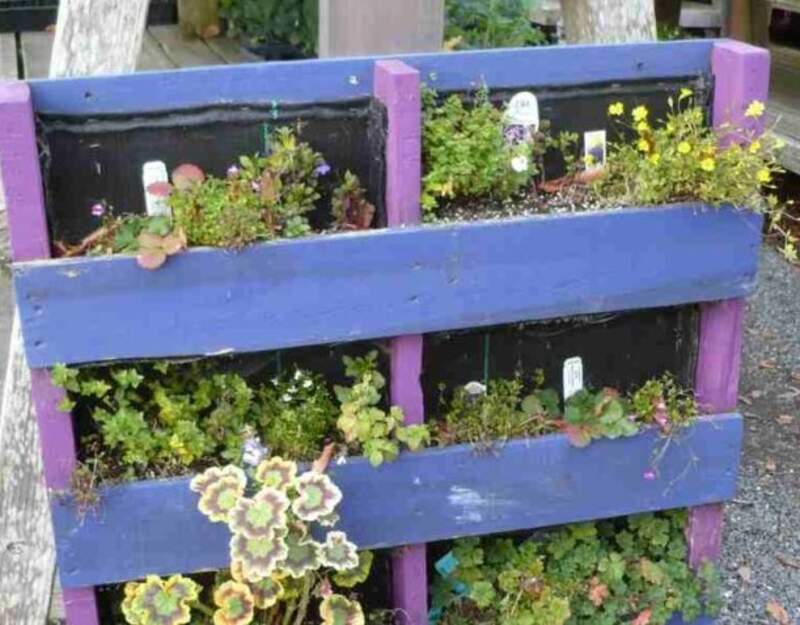
A pallet is a flat platform that enables easy handling, shipping, and lifting of commercial goods or containers. If your outdoor garden is small or you have no greenspace at all, a pallet is a great way to begin or expand a vegetable garden.
Place the garden pallet on your porch or balcony and watch your Chicago garden sprout from the soil. Just make sure the lake’s blistering winds don’t try to knock it over.
Advantages:
- It’s easy to organize your vegetable garden in a pallet. Tall plants grow best on top, while the trailing plants do well at the bottom.
- No weed picking like in a traditional garden
- Keeps the soil in place
Best plants:
Veggies to grow on top:
- Cabbage
- Peppers
- Eggplant
- Bush beans
- Tomato varieties like Tiny Tim, Small Fry, and Toy Boy
Middle:
- Lettuce
- Thyme
- Spinach
- Oregano
- Mint
- Sage
- Basil
- Rosemary
Bottom:
- Summer squash
- Small melons
- Cucumbers
Maintenance tip: Only make a pallet garden with pallets or wood slats stamped with HT. Wood pallets labeled with HT means they were heat treated rather than chemically treated. Chemically treated woods can be unhealthy for your plants.
Growing space between the plants inside your pallet garden may be slim, which means diseases and pests can spread quickly. To keep the spread under control, keep a watchful eye on your plants’ health or choose to grow plant varieties with high disease and pest resistance.
Cost: Pallets range from $5 to $200 depending on size, quality, and material.
8. Repurpose Your Shoe Organizer
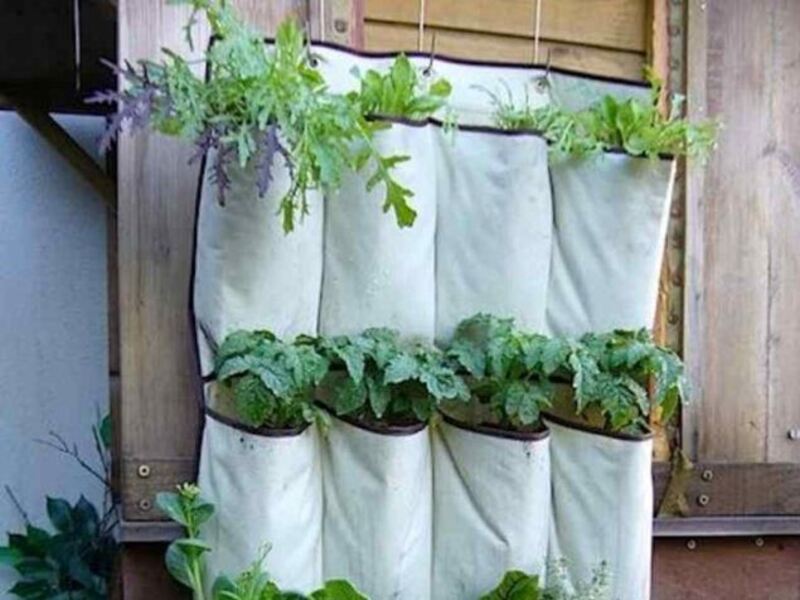
Planning to take your old clothes and shoes to the thrift store? Before you toss the over-the-door shoe organizer into the plastic bag bound for Goodwill, it might still have some use for you. Your shoe organizer could grow your herbs instead of holding your flats.
Hang the shoe organizer in a nice sunny spot, fill the pockets with soil, and pop in your herbs. For added charm and appeal, decorate the pockets with labels for easy picking.
Advantages:
- Hanging your garden off the ground helps prevent pests from making their way to your plants.
- A shoe organizer is easy to move around whenever you need to change your garden’s location.
- No more weed control
- Simple and easy organization
Best plants:
Fill your shoe organizer with your favorite small flowers or tasty herbs.
- Oregano
- Lemon balm
- Parsley
- Basil
- Sage
- Thyme
- Mint
- Rosemary
Maintenance tip: Are your shoe organizer’s pockets not draining? Poke a few small holes at the bottom of each. If you’re growing this vertical garden indoors, place a small box underneath the garden to catch any dripping water.
Water the pockets whenever the soil is dry. You may need to water your vertical garden every day to keep the soil moist.
Cost: If you don’t have an old shoe organizer to reuse, some shoe organizers are available for under $10.
9. Build a DIY Succulent Wreath
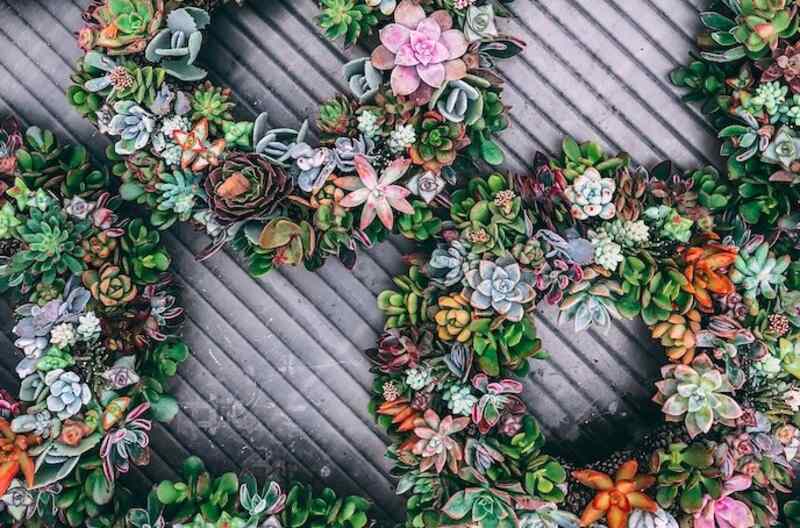
Despite their striking colors and fascinating textures, succulents are low-maintenance and easy to take care of. There’s little to be intimidated by when it comes to caring for a succulent garden.
To turn these fleshy plants into a vertical garden, decorate your walls or front door with succulent wreaths. They’re fun and straightforward to make, and no two will look alike.
Check out how Garden Answer transforms a moss wreath form into a stunning succulent wreath using succulent cuttings, scissors, and greening pins.
Advantages:
- No messy soil or garden pots are needed for this vertical garden project – just decorate your moss wreath and hang.
- A succulent collection can take up lots of space on tables and windowsills. Free up your horizontal surfaces and enjoy your succulents on the wall instead.
- A succulent wreath can make a beautiful, one-of-a-kind art piece.
Best plants:
When choosing the right succulents for your wreath, shop for succulent cuttings instead of succulents in a small nursery pot.
Maintenance tip:
- Lay the wreath flat for four to six weeks to allow the succulent cuttings to develop roots
- Gradually introduce the succulent wreath to sunlight over one week.
- Depending on the time of year, water your succulent wreath every three to 10 weeks. To water, lay the back of the moss form in a tub of water for one hour. Ensure only the back of the moss form is in the water and that none of the succulents are in the water.
Cost: Succulent cuttings usually cost less than $1 each and are sold in bulk. Greening pins cost roughly $6 a pack. Depending on its shape and quality, a moss wreath form costs between $10 and $50.
10. Rely on a Smart Garden
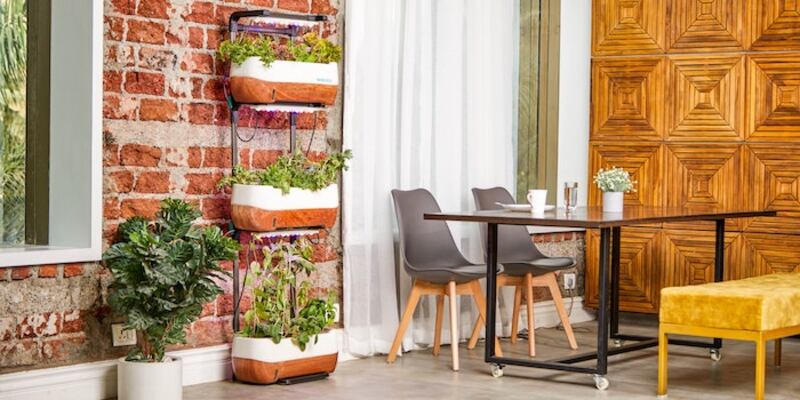
Always on the go in the Windy City? Finding the time to grow a plant – let alone a garden – can be hard when you have places to go and people to see. But what if there was a garden that could sustain itself without your constant attention and care?
Though on the pricier side, smart gardens are an excellent tool for growing your favorite herbs and greens. Most systems alert you when the plants need more water (so you aren’t left guessing), and they come with their own grow light.
Advantages:
- Many smart gardens are self-sustaining and require little effort from you.
- Many smart garden products come with shelving or a vertical stand that helps save space.
- Perfect for Chicago apartments and homes with little sunlight.
- Can offer a fun and successful gardening experience for beginner gardeners
- Planting and maintenance instructions are usually simple and easy to follow.
Best plants:
Most smart gardens come with a pack of herbs that grow best with the product.
Maintenance tip: Smart gardens typically require routine cleaning whenever you change out the plants. But don’t worry about excessive scrubbing or soap-suds – you can get a smart garden that’s machine washable.
Cost: Smart-gardens generally cost between $100 and $200 or more.
11. Build or Buy a Hydroponic System
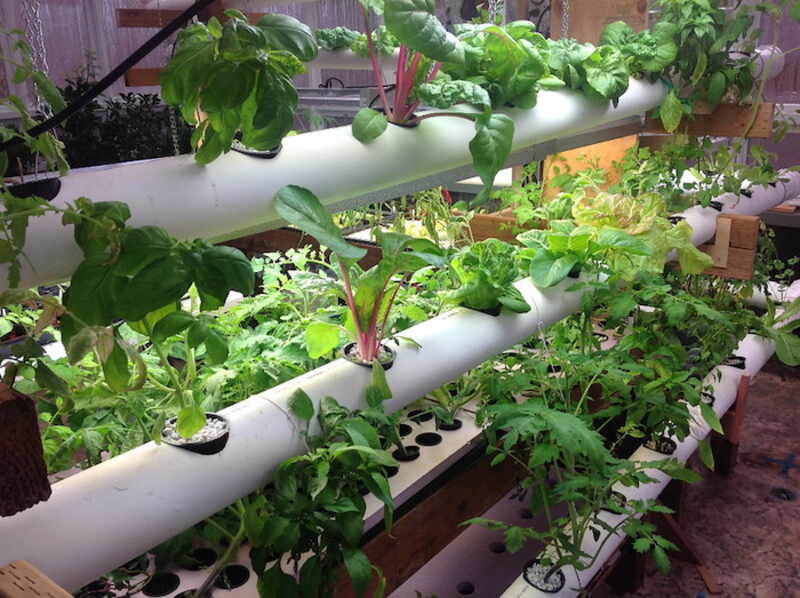
Hydroponics is a gardening approach that grows plants without soil. Instead of soil providing your plants with nutrients, a nutrient-rich water solution does the work.
There are several kinds of hydroponic systems, all with a different approach to growing plants without soil. In some hydroponic gardens, the roots are submerged in the water. Other hydroponic systems have the plants growing in a soil substitute, like sand or gravel.
If you’re a DIY mastermind and have the resources, you can build a hydroponic system at home. You can also buy a hydroponic vertical gardening system with a sleek design that conserves space.
Advantages:
- Gardening without soil helps to prevent soil-borne diseases from infesting your plants.
- With fewer pests and diseases, a hydroponic system requires fewer pesticides and chemicals.
- Plants can absorb nutrients from the water faster than from the soil, leading to faster plant growth.
- Hydroponics requires less water than a traditional vegetable garden.
- No soil erosion
Best plants:
A hydroponics system can feature various herbs, veggies, fruits, and houseplants.
- Oregano
- Chives
- Basil
- Sage
- Mint
- Strawberries
- Tomatoes
- Lettuce
- Spinach
- Cucumber
- Peace lily
- Devil’s ivy
- Spider plant
Maintenance tip: Keep your hydroponic garden’s water reservoir clean and sterile. Otherwise, you risk exposing your plants to bacteria. Remember to clean the reservoir every few weeks. How often you’ll need to change the water will vary depending on the system.
Cost: There are several hydroponic choices available for under $100. Larger systems can cost up to $800 or more.
12. Reuse old water bottles
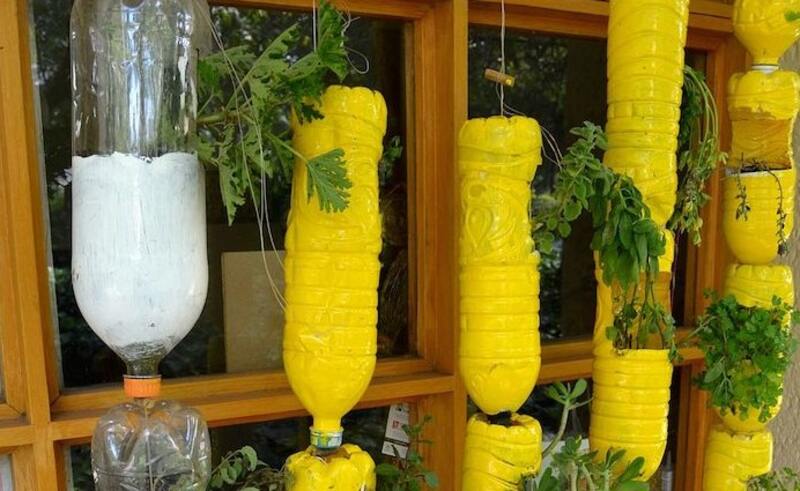
Looking for a vertical garden idea that’s environmentally friendly? Instead of buying flower pots, turn to your recycling bin for old plastic water bottles. Cut an opening in the bottle, fill it with potting soil, hang it with string, and voila! You have the perfect recycled pot for your plant.
Checkout how 5T1 Balcony makes a vertical garden with old plastic bottles.
Advantages:
- Recycling and upcycling are always an advantage in any sized project
- Easy and simple to make
- You can decorate and personalize the water bottles
- No weeding necessary
- Plastic pots are great for your moisture-loving plants.
Best plants:
- Basil
- Parsley
- Rosemary
- Spinach
- Strawberries
- Oregano
- Thyme
- Green onions
- Sage
Maintenance tip: If you’re growing your water bottle garden inside, you’ll want to collect the drainage.
Here’s what to do: Hang the bottle upside down so that the bottle cap is facing down. Poke a hole in the bottle cap for the water to drain out.
Cut a second bottle in half. Slide the second bottle’s bottom half over the upside-down bottle’s cap. The second bottle will be the basin for the drainage.
Cost: All you need to purchase is the soil and plants. For the most eco-friendly and cheapest option, use old water bottles you’ve already used and plan to recycle. Avoid buying new water bottles specifically for this project, as this will create more waste.
13. Grow an Aeroponics Garden
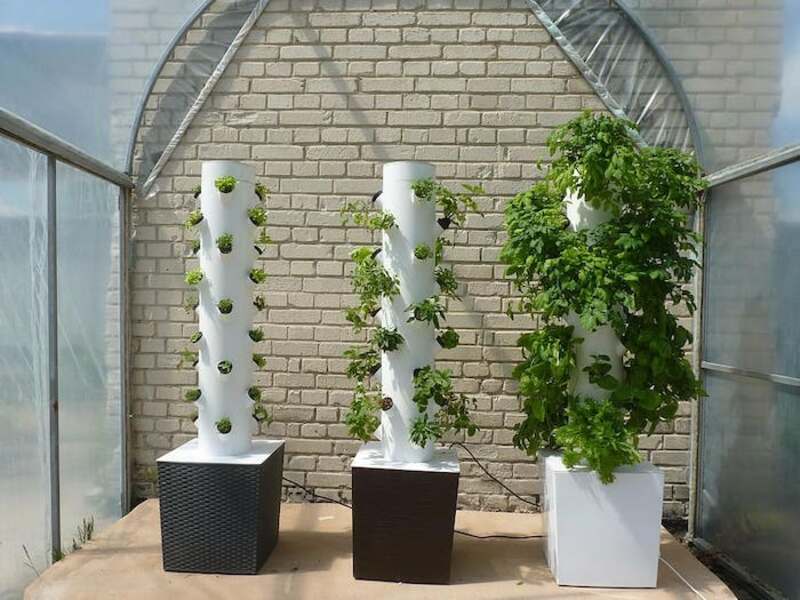
Hydroponic and aeroponic gardening systems are famous for growing healthy plants without using soil. The two approaches are similar, but there is a difference.
Hydroponics is the gardening method of growing plants without soil. Instead of getting their nutrients through the soil, the roots get their nutrients from an enriched water solution. In some hydroponic gardens, the roots are submerged in the water or another soil substitute.
There are many different types of hydroponic systems that use enriched water to grow plants. Aeroponics happens to be one of these systems.
In an aeroponics garden, the roots don’t sit directly in the water like other hydroponic systems. Instead, the roots are exposed in an aeroponics garden and are sprayed with water.
Advantages:
- Aeroponics is a sustainable gardening approach for green thumbs with little to no gardening space.
- Avoids exposing plants to soil-borne diseases.
- Fewer pesticides and chemicals are needed
- No soil erosion
- Conserves more water than a traditional garden
- Roots have better access to oxygen, which promotes better growth and prevents water-logging.
- Nutrients can be applied with precision.
- Easy access to roots if an observation is needed
- Some systems come with an LED light, making growing indoors less of a challenge.
Best plants:
- Lettuce
- Kale
- Snap peas
- Cucumbers
- Peppers
- Small flowers
- Herbs
- Tomatoes
Maintenance tip: Grow the same sized plants next to each other. Otherwise, a small plant may be shaded by a taller plant and not get enough light.
Cost: Some aeroponic gardening systems are available for around $100, but more advanced systems can cost up to $1,000 or more.
14. Watch Climbers Grow up a Trellis

A trellis is a structure with an open framework that allows various types of plants to grow upward. If you love the idea of growing flowering bushes in the yard but are worried about losing space, a vertical trellis can help you grow flowering vines just as beautiful.
There are plenty of trellis ideas and designs to take advantage of – indoor and outdoor – including wall trellises, free-standing trellises, and planter box trellises.
Advantages:
- Keeps vegetables off the ground and away from soil-borne diseases.
- Increases airflow
- Helps leaves dry off
- Makes picking vegetables much easier
- Allows leaves to absorb more sunlight
- A large trellis with climbing vines can help absorb sound and create a privacy screen.
- A trellis with your favorite blooms can make an attractive centerpiece or wall art.
Best plants:
Your trellis can support several vegetables, fruits, and vining flowers, including:
- Peas
- Squash
- Tomatoes
- Beans
- Melons
- Clematis
- Wisteria
- Morning glory
- Climbing rose
- Climbing hydrangea
Maintenance tip: Some climbing vines, such as wisteria, are fast growers. Prune your flowering vines to help keep their rapid growth under control.
Cost: Some trellises cost as low as $10 while others may cost $150 or more.
15. Upcycle Your Gutters
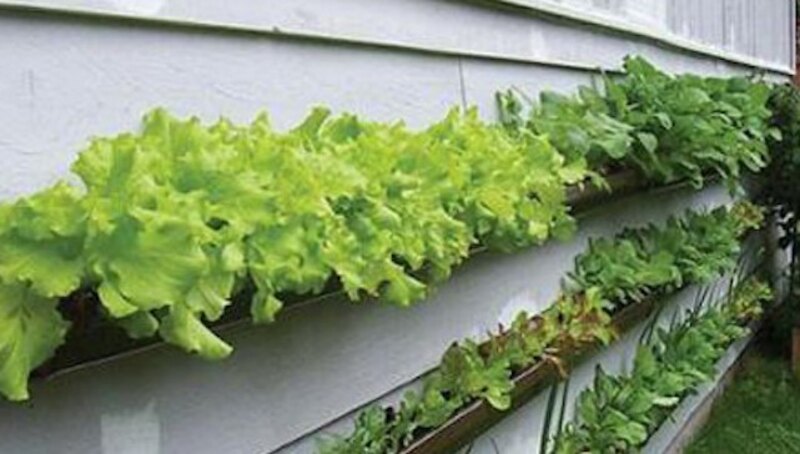
Have a fence around your property? A gutter garden will look great on this vertical surface, especially if you install it at eye level.
You can bring the gutter garden inside, too – and don’t hesitate to get creative with the gutter design. Remodel your gutters to look brand new or buy some upscale gutters that will give your gutter garden that wow factor.
Make sure the gutter’s material is safe for your plants. Some plastics, like PVC, are toxic to plants and can leach into the soil.
Advantages:
- Gutter gardens ensure your plants are kept high off the ground and away from pests.
- A gutter garden can add exciting textures and colors to a bare vertical space.
- Hang the gutter garden from a porch or pergola to create a useful privacy screen.
- A great way to upcycle old gutters.
Best plants:
For your gutter garden, stick to plants with shallow roots.
- Petunias
- Geraniums
- Marigolds
- Strawberries
- Spinach
- Herbs
- Succulents
- Lettuce
- Radishes
Maintenance tip: Drill two drainage holes at one end of each gutter. As you install the gutters, make sure the end with the drainage holes is slightly lower than the end without drainage holes. Hanging your gutters at a slight angle will ensure proper drainage.
Need to collect the drainage? Align the gutters so that the drainage falls into the gutter below. Or use a cup to gather the drainage when watering.
Cost: This vertical garden idea will vary in price depending on the gutter’s material, length, and the number of gutters you need. For the cheapest solution, use your home’s old rain gutters.
16. Stack Your Garden Beds
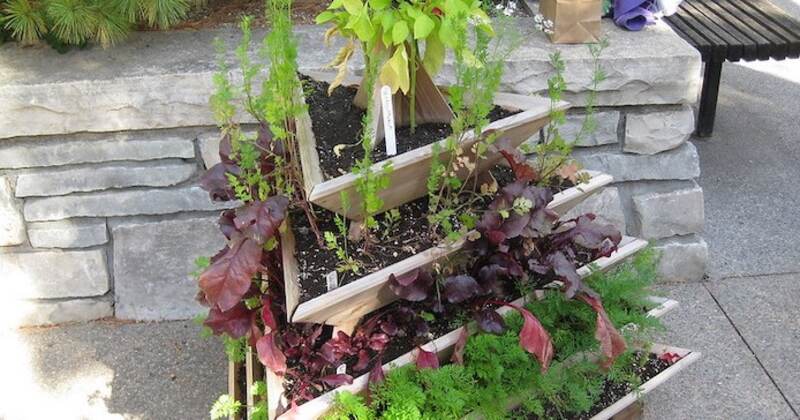
Raised garden beds are an excellent asset to any garden, but what if you have only the garden space for one container bed? Two garden beds would be nice, and three would be a dream. Try your hand at pyramid-shaped or tiered garden beds to create extra space in your small garden.
Advantages:
- Raised garden beds help keep plants away from pests
- A pyramid-shaped garden bed can be appealing to the eye
- The raised levels don’t require as much backache during garden maintenance
- Raised garden beds also give you better control over the gardening soil.
Best plants:
Various vegetables, flowers, herbs, and fruits thrive in raised beds. Before growing any plant, ensure the raised garden bed’s depth is suitable for the plant’s root system.
Maintenance tip: Make sure your stacked beds are level; otherwise, you may run into drainage problems.
Cost: A DIY raised garden bed can cost about $30 to make. Your costs will increase as you increase the number of beds in the garden.
17. Dress Up Your Drawers
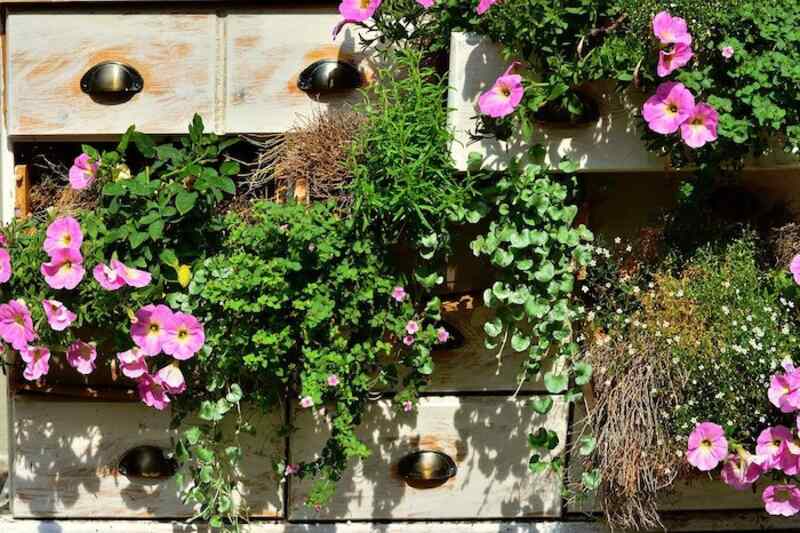
Make your home the coziest Chicago cottage on the block with this vertical garden idea. Move your old dresser onto the porch, fill the drawers with soil and flowers, and watch the neighbors turn their heads. Because when you don’t have a big outdoor space for flower beds and gardening containers, you need to get creative.
Advantages:
- Growing a garden in an old dresser includes storage space for your gardening tools
- Upcycling an old piece of furniture
- No pesky weeds
- Adds a shabby chic look to your landscape
- The dresser’s top is the perfect place to show off your favorite potting containers
Best plants:
When growing plants in shallow drawers, opt for plants with small root systems:
- Strawberries
- Petunias
- Geraniums
- Marigolds
- Cucumbers
- Carrots
- Radishes
- Lettuce
- Herbs
Maintenance tip:
- Are your drawers sturdy? Reinforce them with a drill and screws.
- Remember, some treated woods can leach chemicals into the soil. If your dresser is chemically treated or you’re unsure if it is, use an appropriate liner to separate the soil from the drawers.
- Drill drainage holes at the bottom of each drawer.
Cost: A new dresser can cost around $100. Head to the flea market or thrift store for a cheaper dresser or use the old dresser in your bedroom.
18. Use an A-Frame
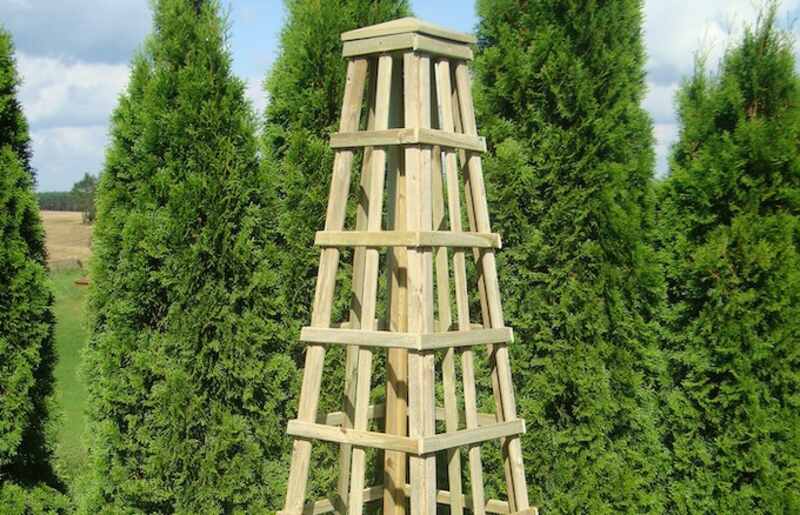
Some of your favorite vegetables, like melons and cucumbers, can take up a lot of garden space with their thick growing vines. Keep their vines off the ground and encourage them to climb up an A-frame trellis.
Advantages:
- Supports the growth of several garden plants
- A large enough A-frame with several plants can create a privacy screen in the garden.
- Saves garden space by preventing vegetables from hogging the ground
Best plants:
- Pole beans
- Peas
- Gourds
- Melons
- Tomatoes
- Squash
- Cucumbers
Maintenance tip: Inspect your A-frame to ensure it’s strong and sturdy. Vegetable vines can get heavy.
Cost: A-frame trellises tend to range between $50 and $150, though they can run much cheaper if turned into a savvy DIY project.
19. Get Crafty with Crates
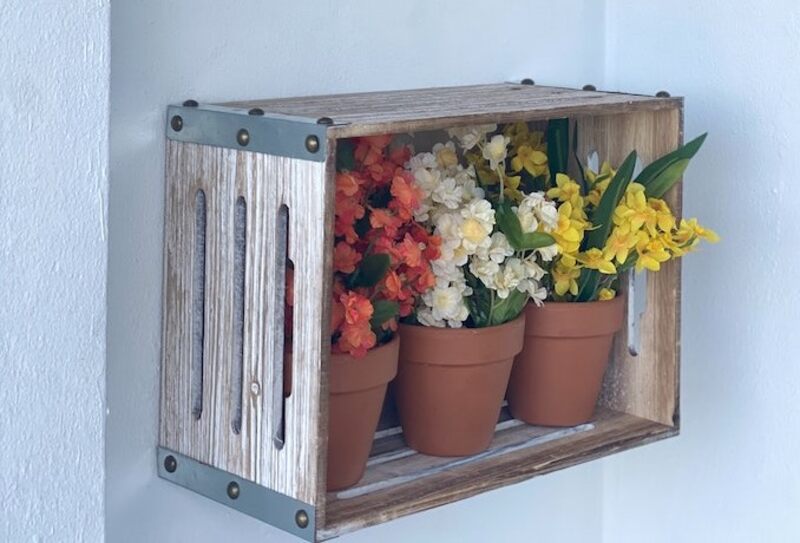
Create a simple and versatile vertical garden with old wooden crates. You can stack them in the corner of your living room to liven up the space, or drill them to the wall of your home office. Enhance the crates with small pots that are easy to rearrange and change out for other plants.
Advantages:
- Wooden crates offer your city home or apartment a quiet, countryside vibe.
- Crates are just the right size for small, short growing plants.
- Stacked crates are easy to rearrange or remove.
Best plants:
Avoid growing big plants in your crate that need plenty of space to grow. Smaller plants will have a better time growing in a crate’s tight quarters.
- Air plant
- Pansies
- Herbs
- Lithops
- Succulents
Maintenance tip: Develop a fertilizer routine for your potted plants to ensure they get the necessary nutrients to flourish and bloom.
Cost: A set of three wooden crates can cost between $30 and $50.
20. Build a Living Wall
This dramatic vertical garden doesn’t have to work hard to take your breath away. A living wall’s greenery can add instant calm and serenity to a busy workspace, cozy studio, or luxury condo. With a cornucopia of different textures, shades of green, and blooming flowers, this stimulating and sophisticated garden wall will put your mighty green thumbs to the test.
Advantages:
- Is a grand art piece
- Can increase a feeling of well-being
- A green workplace can help increase productivity.
- Purifies the air
- Can help reduce noise by absorbing sound
- Absorbs sunlight, reduces temperatures, and can even help save on energy bills.
Best plants:
A living wall can grow herbs, perennials, small shrubs, grasses, fruits, and vegetables.
Before installing any plants into your living wall, contact your local nursery to determine which plants will thrive best in your climate and the wall garden’s ecosystem. Replacing the wall’s dying plants is an essential maintenance step, so you’ll want to make sure the plants you’re growing have the best chance of surviving.
Maintenance tips:
- Remove dead plants and leaves as needed.
- Trim back overgrown or overcrowded plants
- Perform a routine inspection to ensure the irrigation system is working.
Cost: The cost of a living wall will vary depending on square feet and the quality of plants you choose. Check out how a living wall can be a DIY project with this instructional video by HGTV Canada.
Advantages of Vertical Gardening
What most of us know about gardening is that you’re always on your knees, you spend hours in the sun, and you need a big lawn.
This isn’t the case with vertical gardening. You’re hardly ever on your hands and knees, you can grow your vertical garden indoors, and you need little space to grow your garden. And bonus points if you get your vertical garden to look like a piece of wall art.
When to Call a Gardening Pro
Whether you’re an experienced green thumb or you’re opening a pack of seeds for the first time, we all need help with our gardens at some point. Need help with your aeroponic gardening system or need a professional’s advice for choosing the right indoor plants for your condo? Call a gardening professional near you for assistance.
A professional gardener can help install your vertical garden, provide charming garden designs, and even offer additional gardening projects that work when you have limited space.
Main image credit: Unsplash
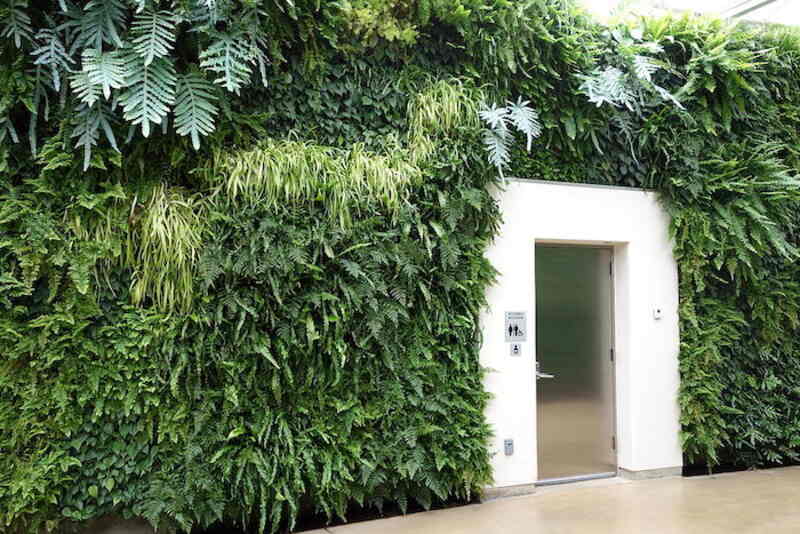
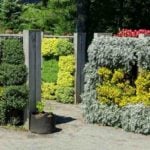

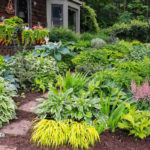
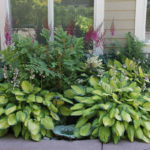
![16 Best Gardening Tools [Reviews]](https://www.lawnstarter.com/blog/wp-content/uploads/2021/11/Best-Gardening-Tools-150x150.jpg)
